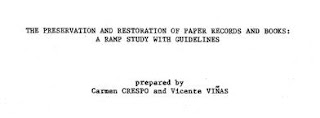 COST Action IE0601 “Wood Science for Conservation of Cultural Heritage”
COST Action IE0601 “Wood Science for Conservation of Cultural Heritage” International Conference on Wooden Cultural Heritage: Evaluation of Deterioration and Management of Change (Hamburg/Germany; October 7-10, 2009)
Link: http://www.woodculther.com/?p=272 Abstract booklet (pdf)
Keynotes
Role of electron microscopy in understanding deterioration of wooden objects of cultural heritage, A. Singh (pdf)
Structural Conservation of Panel Paintings: Tradition, Innovation, Initiatives, J. Wadum (pdf)
Orals Session 2
Consolidation, reinforcement and stabilisation of decorated wooden artefacts ; Prague, 30-31.3.09, I. Kucerova, T. Olstad (pdf)
Wood-destroying insects and decay fungi in and moulds on wooden cultural heritage objects and constructions (Training School); Hamburg, 16-20.3.09, Uwe Noldt (pdf)
Session 3
The use of an electric field for the removal of alum from treated wooden objects, I. V. Christensen et al. (pdf)
New materials used for the consolidation of archaeological wood – past attempts, present struggles, and future requirements, M. Christensen, F. K. Hansen, H. Kutzke (pdf)
Destructive and non-destructive methods for the evaluation of pesticides concentration and emissions from wooden art objects, I. Mayer, K. Hunger, M. Wörle, V. Hubert, U. von Arx (pdf)
Risk management: a case study of the wooden collection held in storage at the folk art museum of Athens, C. Sperantza, M. Papadimitriou, A. Pournou (pdf)
Session 4
Factors that influence the speed of bacterial wood degradation, R. Klaassen (pdf)
Mechanical characteristics of aged Hinoki (Chamaecyparis obtusa Endl.) wood from Japanese historical buildings – Comparative analyses with accelerated aging wood, M. Yokoyama et al. (pdf)
Moisture behaviour of recent and naturally aged wood, T. Gereke, K. Anheuser, E. Lehmann, P. Niemz (pdf)
Numerical Simulation of Historical Pianoforte, S. Saft, M. Kaliske (pdf)
Session 5
Case study: assessment the mechanical properties from an old “pitch pine” timber structure, M.C. Touza Vazquez (pdf)
Characterization of archaeological oak (Quercus sp.) with mid and near infrared spectroscopy, A. Sandak, J. Sandak, M. Zborowska, W. Prądzyński, N. Negri (pdf)
Session 6
X-Ray Microscopy of wood based products, Alan Michette (pdf)
X-Ray Tomography, J. Bielecki (pdf)
Short Orals
Study on the use of polymers in the treatment and conservation of historical wood, Abdel Rahman Medhat, Yassien Zidan, Nesrin M.N. El Hadidi (pdf)
The Conservation of the Historic Timber Roof of the Royal Palace at the Tocnik Castle, Jiri Bláha , M. Kloiber, J. Frankl, M. Drdácký, J. Valach, P. Růžička (pdf)
The Presence of Sulphuric Acid in Alum-conserved Wood – Origin and Consequences, Susan Braovac, Hartmut Kutzke (pdf)
Authentication of ancient stringed musical instruments – the contribution of X-Ray Fluorescence analysis, B. Constantinescu Catalina Pauna, Daniela Stan (pdf)
Fire risk and protection of old timber roofs – need for focused meetings, Helena Cruz, Pedro Palma (pdf)
Evaluation of bacterial wood degradation by FTIR measurement, J Gelbrich, Carsten Mai, Holger Militz (pdf)
Use of boron compounds for treatment of wooden historical objects, Boštjan Lesar, Franc Pohleven and Miha Humar (pdf)
Wood-science approach to the preservation of historic timber structures, Margarita Kisternaya, Valery Kozlov (pdf)
Evaluation of the aging wood from historical buildings as compared with the accelerated aging wood and cellulose – Analysis of color properties, Miyuki Matsuo Misao Yokoyama, et al. (pdf)
Different techniques (SEM, DR-µCT,FIB/SEM) for the evaluation of the deposition of consolidants into waterlogged archaeological wood, G. Giachi, S. Bugani, J.J. Łucejko, F Modugno, F. Tatti (pdf) Diagnosis of Timber Structures and Archaeological Wood of Cultural Heritage, Kalle Pilt, Vello Pallav, Matis Miljan (pdf)
Detection of rot in wood beams by ultrasound method – model and practical studies, Ladislav Reinprecht, Miloš Pánek (pdf)
Monitoring of photodegradation for wood by infrared spectroscopy, Laszlo Tolvaj (pdf)
Reports from STSMs
Termites attacks on ancient timber structures: diagnosis, identification and methods of control, E. Feci (pdf)
Modal analysis and vibrational behaviour of tailpieces in stringed instruments, Eric Fouilhé, Giacomo Goli, Anne Houssay, George Stoppani (pdf)
Posters
Contributions of Janssen PMP towards preservation of wooden (and other) cultural heritage, Jan Bosselaers (pdf)
The Study of Biological Decay with Church Icons on Wooden Support from Romania, Livia Bucsa, Corneliu Bucsa (pdf)
Monitoring Xylophages Insects in the Outdoor Section of “Dumbrava Sibiu”, NMC (the national museum center), ASTRA, Pruna Mariana, Ileana Chirtea (pdf)
The wooden supports in Portugal: the Pentecost in different altarpiece structures, Ana Calvo, Joana Salgueiro, Salomé de Carvalho (pdf)
Follow-up of a panel restoration procedure through image correlation and finite elements modelling, A. Baldit, D. Dureisseix, F. Morestin, H. Maigre (pdf)
Inspection Techniques and Rehabilitation Solutions for Ancient Wooden Structures: some Portuguese Case Studies, A Fejo H. Cruz (pdf)
On 18th and 19th Century Sacristy Furniture in the Maltese Islands: Preservation, Michael Formosa (pdf)
Preliminary testing of timber consolidants applied by impregnation, Dulce Franco Henriques, Lina Nunes, Jorge de Brito (pdf)
Application of spatial analysis operations for the characterization of wood painting features, Frederico Henriques, Alexandre Gonçalves, Ana Calvo, Ana Bailão (pdf)
An artwork: alterable – not unalterable. A critical analysis of the restoration process as a creative factor within an artwork’s new structure. The case of the collection of western panel paintings from the Museum in Tarnowskie Gory, Aleksandra Hola (pdf)
Hygromechanical response of a painted panel in a church: monitoring and computer modelling, Jullien Colmars, Bertrand Marcon, Joseph Gril (pdf)
Time to reach the equilibrium moisture content: in laboratory tests on Poplar (Populus alba L.) mock-up panels, Paola Mazzanti, Luca Uzielli (pdf)
Characterization of archaeological waterlogged wood by pyrolytic and mass spectrometric techniques, J Lucejko, F. Modugno, E. Ribechini, M. Zborowska, M.P. Colombini (pdf)
Potential of reflected light microscopy as a non-invasive identification tool on wooden cultural artefacts, Flavio Ruffinatto, Nicola Macchioni, Guido Boetto, Roberto Zanuttini (pdf)
How to gather aged wood samples from historical buildings in Japanese context, Misao Yokoyama, Shuichi Kawai, Junji Sugiyama (pdf)
Characterization of archaeological wood degradation with selected nondestructive methods, Magdalena Zborowska, Anna Sandak, Jakub Sandak, Sławomir Borysiak, Wlodzimierz Prądzyński (doc)





















